HISTORY / ORIGIN OF GERMAN SHEPHERD DOGS
HISTORY AND ORIGIN OF GERMAN SHEPHERD
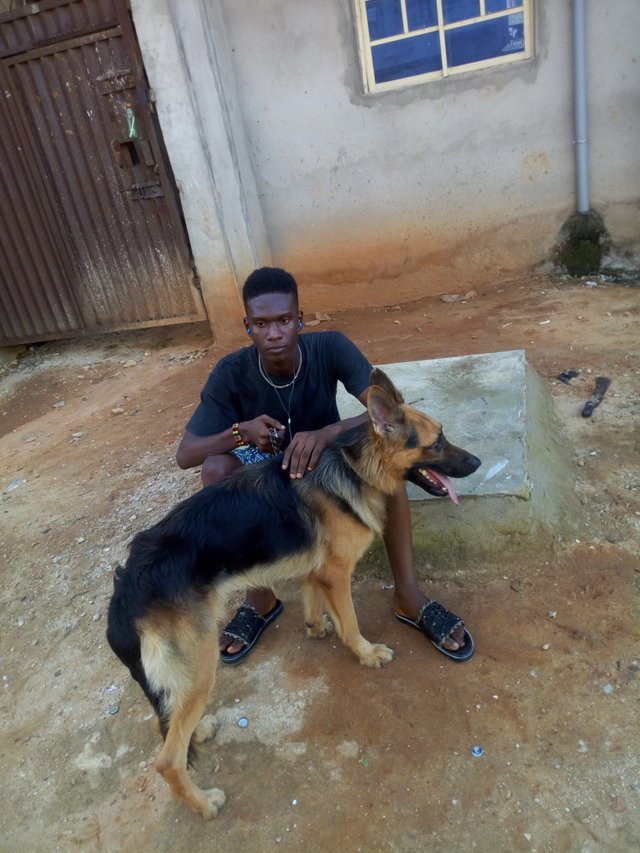
ORIGIN
In Europe during the 1850s, attempts were being made to standardise breeds. The dogs were bred to preserve traits that assisted in their job of herding sheep and protecting flocks from predators. In Germany this was practiced within local communities, where shepherds selected and bred dogs that they believed had the skills necessary for herding sheep, such as intelligence, speed, strength, and keen senses of smell. The results were dogs that were able to do such things, but that differed significantly, both in appearance and ability, from one locality to another.
To combat these differences, the Phylax Society was formed in 1891 with the intention of creating standardised dog breeds in Germany. The society disbanded after only three years due to ongoing internal conflicts regarding the traits in dogs that the society should promote; some members believed dogs should be bred solely for working purposes, while others believed dogs should be bred also for appearance. While unsuccessful in their goal, the Phylax Society had inspired people to pursue standardising dog breeds independently.
Max von Stephanitz, an ex-cavalry captain and former student of the Berlin Veterinary College, was one such ex-member. He believed strongly that dogs should be bred for working.
In 1899, Von Stephanitz was attending a dog show when he was shown a dog named Hektor Linksrhein. Hektor was the product of few generations of selective breeding and completely fulfilled what Von Stephanitz believed a working dog should be. He was pleased with the strength of the dog and was so taken by the animal’s intelligence, loyalty, and beauty, that he purchased him immediately. After purchasing the dog he changed his name to Horand von Grafrath and Von Stephanitz founded the Verein für Deutsche Schäferhunde (Society for the German Shepherd Dog). Horand was declared to be the first German Shepherd Dog and was the first dog added to the society’s breed register.
Horand became the centre-point of the breeding programs and was bred with dogs belonging to other society members that displayed desirable traits. Although fathering many pups, Horand’s most successful was Hektor von Schwaben. Hektor was inbred with another of Horand’s offspring and produced Beowulf, who later fathered a total of eighty-four pups, mostly through being inbred with Hektor’s other offspring. In the original German Shepherd studbook, Zuchtbuch für Deutsche Schäferhunde (SZ), within the two pages of entries from SZ No. 41 to SZ No. 76, there are four Wolf Crosses. Beowulf’s progeny also were inbred and it is from these pups that all German Shepherds draw a genetic link. It is believed the society accomplished its goal mostly due to Von Stephanitz’s strong, uncompromising leadership and he is therefore credited with being the creator of the German Shepherd Dog.
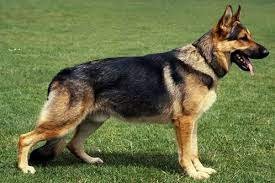
POPULARITY
When the UK Kennel Club first accepted registrations for the breed in 1919, fifty-four dogs were registered, and by 1926 this number had grown to over 8,000. The breed first gained international recognition at the decline of World War I after returning soldiers spoke highly of the breed, and animal actors Rin Tin Tin and Strongheart popularised the breed further. The first German Shepherd Dog registered in the United States was Queen of Switzerland; however, her offspring suffered from defects as the result of poor breeding, which caused the breed to suffer a decline in popularity during the late 1920s.
Popularity increased again after the German Shepherd Sieger Pfeffer von Bern became the 1937 and 1938 Grand Victor in American Kennel club dog shows, only to suffer another decline at the conclusion of World War II, due to anti-German sentiment of the time. As time progressed, their popularity increased gradually until 1993, when they became the third most popular breed in the United States. As of 2009, the breed was the second most popular in the US. Additionally, the breed is typically among the most popular in other registries. The German Shepherd Dog’s physique is very well suited to athletic competition. They commonly compete in shows and competitions such as agility trials.
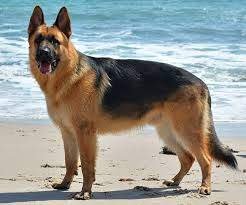
NAMING OF GERMAN SHEPERD
The breed was named Deutscher Schäferhund by von Stephanitz, literally translating to “German Shepherd Dog”. The breed was so named due to its original purpose of assisting shepherds in herding and protecting sheep. At the time, all other herding dogs in Germany were referred to by this name; they thus became known as Altdeutsche Schäferhunde or Old German Shepherd Dogs.
The direct translation of the name was adopted for use in the official breed registry; however, at the conclusion of World War I, it was believed that the inclusion of the word “German” would harm the breed’s popularity, due to the anti-German sentiment of the era. The breed was officially renamed by the UK Kennel Club to “Alsatian Wolf Dog” which was also adopted by many other international kennel clubs. Eventually, the appendage “wolf dog” was dropped. The name Alsatian remained for five decades, until 1977, when successful campaigns by dog enthusiasts pressured the UK Kennel Club to allow the breed to be registered again as German Shepherd Dogs. The word “Alsatian” still appeared in parentheses as part of the formal breed name and was only removed in 2010.
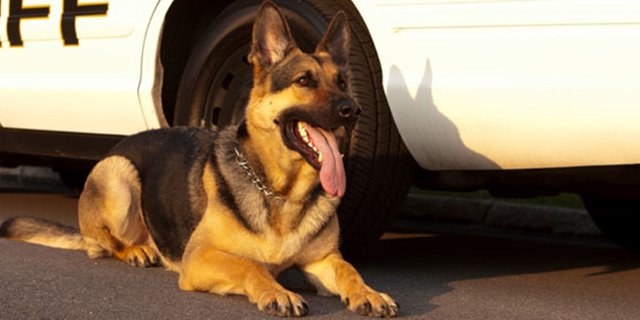
MODERN BREED
The modern German Shepherd Dog is criticised for straying away from von Stephanitz’s original ideology for the breed: that German Shepherds should be bred primarily as working dogs, and that breeding should be strictly controlled to eliminate defects quickly. Critics believe that careless breeding has promoted disease and other defects. Under the breeding programs overseen by von Stephanitz, defects were quickly bred out; however, in modern times without regulation on breeding, genetic problems such as colour-paling, hip dysplasia, monorchidism, weakness of temperament, and missing teeth are common, as well as bent or folded ears which never fully turn up when reaching adulthood.
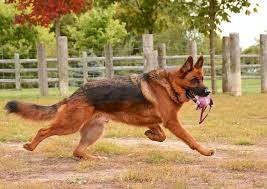
DESCRIPTION
German Shepherds are large sized dogs, generally between 55 and 65 centimetres (22 and 26 in) at the withers, with an ideal height of 63 centimetres (25 in) according to Kennel Club standards. Weight is 30–40 kilograms (66–88 lb) for males and 22–32 kilograms (49–71 lb) for females. They have a domed forehead, a long square-cut muzzle and a black nose. The jaws are strong, with a scissor-like bite. The eyes are medium-sized and brown with a lively, intelligent, and self-assured look. The ears are large and stand erect, open at the front and parallel, but they often are pulled back during movement. They have a long neck, which is raised when excited and lowered when moving at a fast pace. The tail is bushy and reaches to the hock.
German Shepherds can be a variety of colours, the most common of which are tan/black and red/black. Most colour varieties have black masks and black body markings which can range from a classic “saddle” to an over-all “blanket.” Rarer colour variations include the sable, all-black, all-white, liver, and blue varieties. The all-black and sable varieties are acceptable according to most standards; however, the blue and liver are considered to be serious faults and the all-white is grounds for instant disqualification in some standards.
German Shepherds sport a double coat. The outer coat, which sheds all year round, is close and dense with a thick undercoat. The coat is accepted in two variants; medium and long. The long-hair gene is recessive, making the long-hair variety rarer. Treatment of the long-hair variation differs across standards; they are accepted under the German and UK Kennel Clubs but are considered a fault in the American Kennel Club.
INTELLIGENCE
German Shepherds were bred specifically for their intelligence, a trait for which they are now famous. In the book The Intelligence of Dogs, author Stanley Coren ranked the breed third for intelligence, behind Border Collies and Poodles. He found that they had the ability to learn simple tasks after only five repetitions and obeyed the first command given 95% of the time. Coupled with their strength, this trait makes the breed desirable as police, guard, and search and rescue dogs, as they are able to quickly learn various tasks and interpret instructions better than other large breeds.
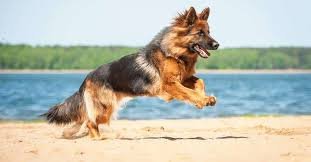
TEMPERAMENT
German Shepherds are highly active dogs, and described in breed standards as self-assured. The breed is marked by a willingness to learn and an eagerness to have a purpose. They are curious which makes them excellent guard dogs and suitable for search missions. They can become over-protective of their family and territory, especially if not socialised correctly. They are not inclined to become immediate friends with strangers. German Shepherds are highly intelligent and obedient.
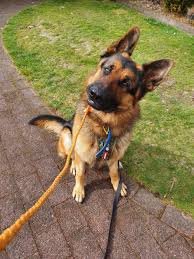
HEALTH
Many common ailments of the German Shepherds are a result of the inbreeding practiced early in the breed’s life. One such common ailment is hip and elbow dysplasia which may lead to the dog experiencing pain in later life, and may cause arthritis. A study by the University of Zurich in police working dogs found that 45% were affected by degenerative spinal stenosis, although the sample studied was small. The Orthopedic Foundation for Animals found that 19.1% of German Shepherd are affected by hip dysplasia. Due to the large and open nature of their ears, Shepherds are prone to ear infections. German Shepherds, like all large bodied dogs, are prone to bloat.
According to a recent survey in the UK, the median life span of German Shepherds is 10.95 years, which is normal for a dog of their size. Degenerative myelopathy (CDRM), a neurological disease, occurs with enough regularity specifically in the breed to suggest that the breed is predisposed to it. A very inexpensive DNA saliva test is now available to screen for Degenerative Myelopathy. The test screens for the mutated gene that has been seen in dogs with degenerative myelopathy. Now that a test is available the disease can be bred out of breeds with a high preponderance. The test is only recommended for predisposed breeds, but can be performed on DNA from any dog on samples collected through swabbing the inside of the animal’s cheek with a sterile cotton swab.
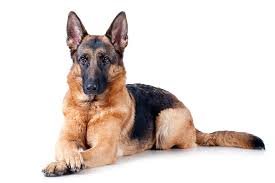
CONTROVERSY THAT CAME UP CONCERNING THE GSD
The Kennel Club has been embroiled in a dispute with German Shepherd breed clubs about the issue of soundness in the show-strain breed. The show-strains have been bred with an extremely sloping topline (back) that causes poor gait in the hind legs. Working-pedigree lines, such as those in common use as service dogs, generally retain the traditional straight back of the breed. The debate was catalyzed when the issue was raised in the BBC documentary, Pedigree Dogs Exposed, which said that critics of the breed describe it as “half dog, half frog”. An orthopedic vet remarked on footage of dogs in a show ring that they were “not normal”.
The Kennel Club’s position is that “this issue of soundness is not a simple difference of opinion, it is the fundamental issue of the breed’s essential conformation and movement.” The Kennel Club has decided to retrain judges to penalize dogs suffering these problems. It is also insisting on more testing for hemophilia and hip dysplasia, other common problems with the breed.
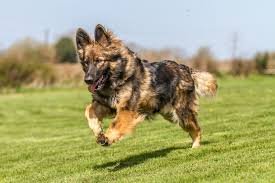
German Shepherds are a very popular selection for use as working dogs. They are especially well known for their police work, being used for tracking criminals, patrolling troubled areas, and detection and holding of suspects. Additionally thousands of German Shepherds have been used by the military. Usually trained for scout duty, they are used to warn soldiers to the presence of enemies or of booby traps or other hazards. German Shepherds have also been trained by military groups to parachute from aircraft.
The German Shepherd Dog is one of the most widely used breeds in a wide variety of scent-work roles. These include search and rescue, cadaver searching, narcotics detection, explosives detection, accelerant detection, and mine detection dog, among others. They are suited for these lines of work because of their keen sense of smell and their ability to work regardless of distractions.
At one time the German Shepherd Dog was the breed chosen almost exclusively to be used as a guide dog for the visually impaired. In recent years, Labradors and Golden Retrievers have been more widely used for this work, although there are still German Shepherds being trained. A versatile breed, they excel in this field due to their strong sense of duty, their mental abilities, their fearlessness, and their attachment to their owner.
German Shepherd Dogs are used for herding and tending sheep grazing in meadows next to gardens and crop fields. They are expected to patrol the boundaries to keep sheep from trespassing and damaging the crops. In Germany and other places these skills are tested in utility dog trials also known as HGH (Herdengebrauchshund) herding utility dog trials.
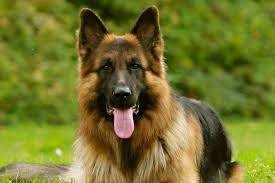
SUMMARY OF THE HISTORY AND ORIGIN OF GSD
As the name suggests, the German Shepherd originated in Germany in the late 1800s. The most intelligent, responsive and obedient local shepherd dogs in Germany were bred to create what is now known as the German Shepherd. This breed was responsible for herding sheep and protecting flocks from predators. They were not considered pets or companions, but rather servants for farmers. Their intelligence, speed, strength and keen sense of smell, made them the perfect choice as sheep herders. Although German Shepherds were considered strictly workers, rather then household pets, farmers did provide food, protection and shelter to the breed.
By the beginning of World War I the German Shepherd was popular throughout Germany and quickly spread to other parts of the world. People loved German Shepherds for their loyal and couragous character.
Due to the breed’s reputation for being couragous and easy-to-train, German Shepherds were welcomed as police dogs and sight dogs for the blind. Their superb sense of smell and couragous character made the German Shepherd an ideal police dog. Their faithful observance to what is going on around them, along with their patience, landed them the role as leader to the blind.
These outstanding qualities and characteristics make the German Shepherd a wonderful domestic companion, protector and friend. The breed is reserved with strangers at first, but warms up quickly. This characteristic makes them excellent watch dogs, especially for children. It’s good to socialize them when they are young and to take them on long walks or runs all throughout their life.
The German Shepherd Dog (Deutshe Schäferhund) descends from the family of German herding dogs that, until the late 19th century, varied in type from district to district.
In the waning years of the 1800s, a German cavalry officer, Captain Max von Stephanitz, made it his mission to develop the ideal German herder. Von Stephanitz and like-minded breeders crossed various strains from the northern and central districts of Germany, resulting in the ancestors of today’s German Shepherd Dog (GSD).
Von Stephanitz co-founded the world’s first club devoted to GSDs and spent 35 years promoting and refining the breed. Today, the GSD’s versatility is so thoroughly deployed in the performance of myriad tasks that it is easy to forget that the breed was originally created to herd sheep. The GSD’s now-famous qualities—intelligence, agility, speed, stealth, and the overall air of firm authority—were forged not in the police academy but in the sheep pasture.
GSDs became popular in the United States in the early 1900s, thanks in part to the adventures of canine movie stars Rin-Tin-Tin and Strongheart. The GSD is among those German breeds, the Dachshund is another, that suffered from anti-German sentiment during and after the world wars. In World War I–era Britain, the breed was referred to as the Alsatian, a name many British dog lovers still prefer.
With the rise of modern livestock management and the decline of herding as a canine occupation, von Stephanitz shrewdly promoted his breed as an ideal K-9 worker. The GSD is today the preferred dog for police and military units the world over.
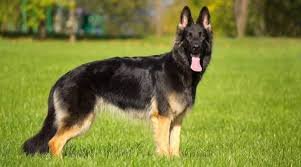
Dog (Canis lupus familiaris)
Other names for the German Shepherd Dog
Alsatian
Berger Allemand
Deutscher Schäferhund
GSD
Schäferhund
Nice and enlightening. I am a dog lover.
A really good and useful article. Thanks for sharing. I'm a former Cavalry's Officer of Venezuela's Army and in some missions (border patrol, security posts) The military police supporting us employed K-9 units to detect illegal substances and weapons: most of the K-9 were German Shepherds, well trained and very noble dogs. Regards from Venezuela.
@joalsaro german shepherds are just wonderfully made by nature. Regards from Nigeria
@micharaph you really digged deep in this exposition.Its an eye opener too.
German shepherds are really strong,and posses high degree of smell and learning ability.
Thanks for bringing the knowledge to the fore.
@samuel20 thanks. Knowledge is power